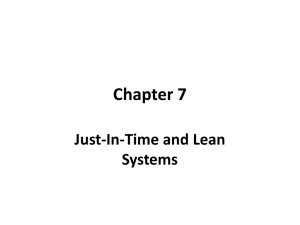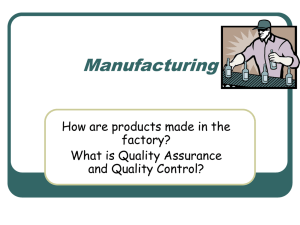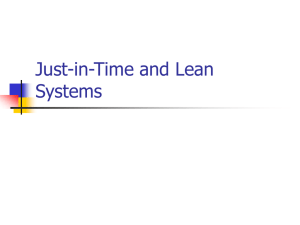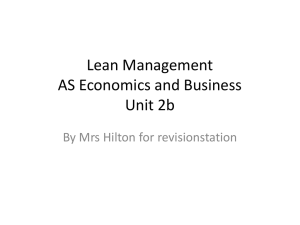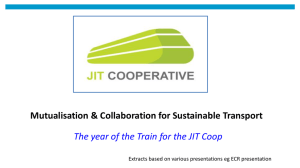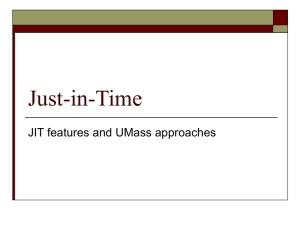Sistem Produksi Tepat Pertemuan 1 - TIN416
advertisement
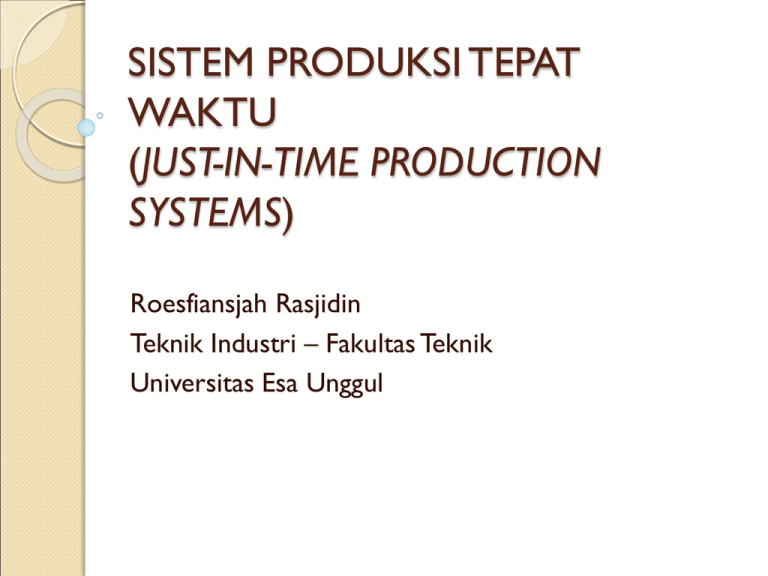
SISTEM PRODUKSI TEPAT WAKTU (JUST-IN-TIME PRODUCTION SYSTEMS) Roesfiansjah Rasjidin Teknik Industri – Fakultas Teknik Universitas Esa Unggul Penilaian Akhir UAS: 35% UTS: 30% Tugas/Quiz: 15% Kehadiran: 10% Partisipasi kelas: 10% Rencana Perkuliahan Asal, tujuan & definisi JIT Keuntungan, perbandingan dgn sistem konvensional, dan skema JIT Konsep 5S dan persiapan sumberdaya manusia Sistem Tarik dan Sistem Dorong Sistem Kanban Produksi Lot Kecil Reduksi Waktu Set-up SMED dan Teknik Reduksi Waktu Set-up Pemeliharaan dan perbaikan mesin dan peralatan Teknologi kelompok dan sel manufaktur Screening, pokayoke & jidoka Leveling production Sinkronisasi dan penyeimbangan proses PENGANTAR History and Origins of JIT Definition and Objectives of JIT JIT Benefits and Success Factors Comparison: Conventional vs JIT Systems JIT Scheme Origins of Just-in-Time JIT originated in Japan, post WWII Driven by a need survive after the devastation caused by the war JIT gained worldwide prominence in the 1970s Japanese firms, particularly Toyota, in 1970's and 1980's © Wiley 2007 Origins of JIT (cont’d) Taiichi Ohno and Shigeo Shingo Geographical and cultural roots Japanese objectives “catch up with America” (within 3 years of 1945) small lots of many models Japanese motivation Japanese domestic production in 1949 – 25,622 trucks, 1,008 cars American to Japanese productivity ratio – 9:1 Era of “slow growth” in 1970's 7 Waste: Time, Material & Resources Machine downtime Bad design Unreliable supplier Poor quality Inefficient layout Waste Elimination Ohno devised a new system of production based on the elimination of waste. Waste was eliminated by: just-in-time - items only move through the production system as and when they are needed autonomation - automating the production system so as to include inspection - human attention only being needed when a defect is automatically detected whereupon the system will stop and not proceed until the problem has been solved JIT Objectives Ultimate objectives: Zero Inventory. Zero lead time. Zero failures. Flow process. Flexible manufacture. Eliminate waste. 10 JIT Definition Just-in-time (JIT) is defined in the APICS dictionary as “a philosophy of manufacturing based on planned elimination of all waste and on continuous improvement of productivity”. It also has been described as an approach with the objective of producing the right part in the right place at the right time (in other words, “just in time”). JIT Benefit Summary Manufacturing cycle time reduction Inventory reductions: Raw materials Work-in-process Finished goods Labor cost reductions: Direct Indirect Space requirements reduction Quality cost reduction Material cost reduction Improvement Aggregate percentage (3-5 years) 80-90% Annual percentage 30-40% 35-70 70-90 60-90 10-30 30-50 25-60 10-50 20-60 40-80 25-60 5-25 3-20 3-20 25-50 10-30 2-10 12 Just-in-Time Success Factors Employee Empowerment Suppliers Quality JIT Preventive Maintenance Layout Inventory Scheduling Three Elements of JIT © Wiley 2007 JIT and Competitive Advantage JIT Requires: JIT and Competitive Advantage Which Results In: Which Yields: Comparison: Conventional vs JIT Systems Conventional 1. Some defect one acceptable 2. Large are efficient (more is better) 3. Fast production is efficient 4. Inventory provides safety 5. Inventory smooths production 6. Inventory is an asset 7. Queues are necessary 8. Suppliers are adversaries 9. Multiple supply sources lead to safety 10. Breakdown maintenance is enough 11. Long lead time is better 12. Setup time is given 13. Management is by edict 14. Work force is specialized Just - In - Time 1. Zero defect are necessary & attainable 2. Ideal lotsize is one (less is better) 3. Balanced production is efficient (faster production is a waste) 4. Safety stock is a waste 5. Inventory is undesirable 6. Inventory is a liability 7. Queues should be eliminated 8. Supplier are partners 9. Fewer sources of supply lead to control 10. Preventive maintenance is essential 11. Short lead time is better 12. Setup time should be zero 13. Management is by consencus 14. Work force is multifunctional Just In Time Scheme Introduction of Procedurs Revolution Awareness 5 S for work place Improvement Flow Manufacturing Multi-Process Handling Quality Assurance Leveled Production Change Over Maintenance & Safety Standard Operation Jidoka (Autonomation) JUST IN TIME Man Power Reduction Visual Control Kanban




